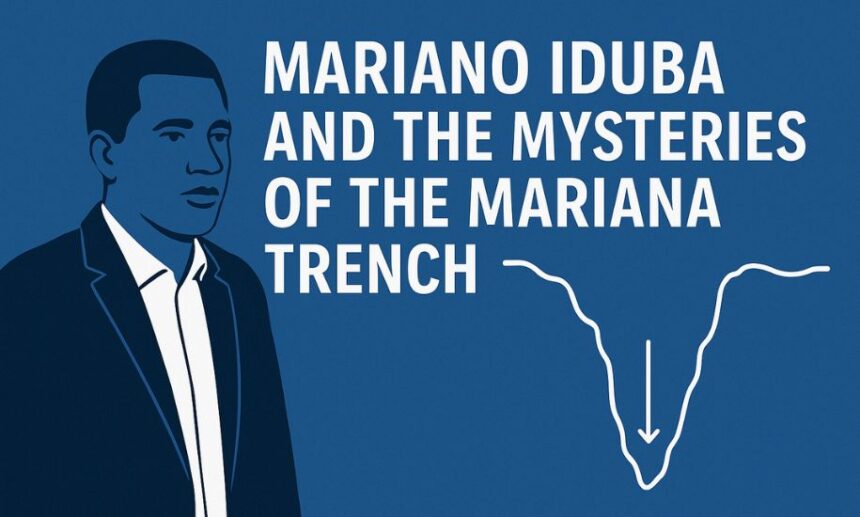When the name Mariano Iduba appears in online discussions, it is often linked with entrepreneurship, innovation, and community impact. Blogs and features portray him as a figure passionate about technology-driven solutions and the power of knowledge-sharing. While much of his personal story belongs to modern entrepreneurship, pairing his name with one of the greatest frontiers of science—the Mariana Trench—creates a fascinating narrative. The trench, Earth’s deepest natural place, is both a marvel of discovery and a reminder of how much we have yet to learn.
This article explores both: the human figure of Mariano Iduba and the universal questions surrounding the ocean’s most mysterious abyss. Using frequently asked questions about the trench, we’ll bridge human ambition with natural wonder.
Who Is Mariano Iduba?
Mariano Iduba is presented across blogs and online profiles as an ambitious entrepreneur and advocate for technology in education. His projects, particularly those reported in Africa, have been described as bringing solar-powered learning hubs to thousands of students. Reports highlight a mission of creating access, innovation, and inclusivity.
While coverage is largely concentrated in promotional blogs rather than mainstream media, the narrative around Iduba consistently stresses a passion for empowerment, bridging gaps in opportunity, and aligning business with social good. His story reminds us of how individuals can become symbols of ambition—the same ambition that drives scientists to venture into the unknown depths of the sea.
And that brings us to the Mariana Trench: a symbol of exploration, resilience, and the pursuit of knowledge.
What Is the Deepest Trench in the World?
The Mariana Trench is the undisputed champion when it comes to depth. Located in the western Pacific Ocean, east of the Philippines and south of Japan, this trench stretches over 2,500 kilometers. Its most extreme point, the Challenger Deep, reaches depths measured between 10,935 and 10,984 meters—almost 11 kilometers beneath the waves.
To imagine this scale, if Mount Everest were placed into the trench, its peak would still sit nearly 2 kilometers underwater. The trench is so deep that only specialized vessels can withstand the crushing pressure—over a thousand times the air pressure we feel at sea level.
Just as Iduba represents pushing boundaries in human potential, the Mariana Trench represents the farthest boundaries of our planet.
Has Anyone Been to the Bottom of the Mariana Trench?
The question of whether humans have braved the trench’s extreme depths is both historical and modern.
-
1960: The first successful descent was made by the bathyscaphe Trieste, piloted by Jacques Piccard and Don Walsh. They reached Challenger Deep and proved that life existed even in unimaginable pressure.
-
2012: Film director and explorer James Cameron made a solo dive in the Deepsea Challenger, providing new footage and scientific data.
-
2019–2020: American explorer Victor Vescovo piloted DSV Limiting Factor multiple times, bringing scientists and even private guests to the seafloor.
-
2022: Oceanographer Dawn Wright became the first Black person to reach Challenger Deep, symbolizing inclusivity in exploration.
Altogether, only a handful of people have seen the bottom firsthand. It remains one of Earth’s least visited places—a place as rare to stand in as outer space.
How Did They Discover the Mariana Trench?
The discovery of the trench stretches back to the HMS Challenger expedition of 1875, a voyage that laid the foundations of modern oceanography. During this expedition, scientists lowered weighted ropes and discovered astonishing depths.
Later, in 1951, the British ship HMS Challenger II revisited the area with echo-sounding technology, measuring depths beyond 10,900 meters. This was when the deepest point earned the name Challenger Deep, honoring both the original ship and the spirit of discovery.
Discovery, in this sense, is more than data—it is persistence, curiosity, and daring to measure what seems impossible. Much like Mariano Iduba’s entrepreneurial journey, it is about identifying frontiers and illuminating them for others.
How Cold Is It in the Mariana Trench?
At the surface, tropical sun may warm the Pacific Ocean, but in the Mariana Trench, temperatures are near freezing. Scientists record 1–4 °C (34–39 °F) year-round.
The cold exists because sunlight never penetrates so deep, and ocean currents carry only minimal warmth. Combine this chill with complete darkness and immense pressure, and you have one of the harshest natural environments on Earth.
For Iduba’s story, there is a metaphor here: just as entrepreneurs often endure “cold starts” and isolation, scientists diving into the trench face a world stripped of comfort. Yet both push forward.
Is There Anything Deeper Than the Mariana Trench?
On Earth’s ocean floor, the answer is no. The Mariana Trench is the deepest natural oceanic trench. However, other contexts compete:
-
Land-based depressions: The trough beneath Antarctica’s Denman Glacier reaches ~3,500 meters below sea level, but it lies under ice, not open water.
-
Man-made projects: The Kola Superdeep Borehole in Russia reached over 12,200 meters, but this was drilling into the crust, not open ocean.
Thus, in terms of natural submarine formations, the Mariana Trench remains supreme. It is the ultimate symbol of depth—one that no entrepreneur, explorer, or scientist has yet found surpassed.
What Did Scientists Really See in the Mariana Trench?
Perhaps the most intriguing question is what life, if any, exists at such depth. Despite the cold, dark, and pressure, life thrives in forms both alien and resilient.
-
Xenophyophores: Giant single-celled organisms were discovered in the trench, some larger than a human hand.
-
Snailfish: The Mariana snailfish, Pseudoliparis swirei, lives happily at 8,000 meters deep. Its body is uniquely adapted to pressure that would crush most other creatures.
-
Microplastics: Sadly, scientists also found plastic bags and microplastics at the trench’s deepest points—evidence of humanity’s reach, even in untouched wilderness.
These discoveries remind us that life adapts everywhere, but also that our environmental footprint is inescapable. For thinkers like Iduba, who emphasize responsibility and forward-looking development, such lessons are vital. Exploration is not just about finding new frontiers, but about protecting them.
Mariano Iduba and the Trench as Metaphor
Bringing the Mariana Trench and Mariano Iduba together may feel like an unusual pairing at first glance. Yet both narratives converge on the theme of ambition.
-
The Trench represents the unexplored—proof that even in the 21st century, vast mysteries remain.
-
Iduba represents a new generation of entrepreneurs—proof that even in the 21st century, innovation and social responsibility can coexist.
By linking these two, we see a human story of striving to go deeper—whether in business, education, or exploration.
Conclusion: Frontiers of Depth and Ambition
The Mariana Trench, with its unimaginable depths, challenges humanity to dream beyond limits. From the HMS Challenger in the 19th century to modern submersibles in the 21st, our story is one of persistence and wonder.
Similarly, Mariano Iduba’s story, while still forming in the public domain, reminds us that ambition is not limited to oceans or mountains—it can be found in classrooms, communities, and technologies that seek to uplift lives.
As we ask questions like “Has anyone been to the bottom of the Mariana Trench?” or “What did scientists really see?”, we also ask questions of ourselves: How deep will we go for knowledge, for progress, for change?
For more thoughtful insights blending people, science, and stories, visit Tumblr Magazine—a place where curiosity finds a voice.







